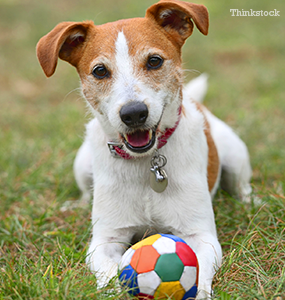Background
The Parson Russell Terrier originated in south England during the mid-1800s. It’s likely that he was developed by crossing the former Black and Tan Terrier with the Old English White Terrier. The Parson was named after the well-regarded huntsman, Rev. John Russell.
Later, the Parson’s bloodlines were crossed with the Welsh Corgi, along with other breeds, creating the Jack Russell Terrier.
The American Kennel Club recognized the Parson Russell Terrier in 1997.
Sizing up
- Weight: 13 to 17 lbs.
- Height: 13 to 14 inches
- Coat: Smooth and weatherproof
- Color: White, white with black or tan markings, or tri-color
- Life expectancy: 12 to 14 years
What’s the Parson Russell Terrier like?
The Parson Russell Terrier is friendly, active, and affectionate. He loves his family and is great with kids, but toddlers tend to be a little too rough for him. Parsons are very curious dogs, and excel at backyard excavation. They need plenty of exercise to get all of their energy out -- whether it’s a great game of fetch, a nice walk or a hike. They’re great at agility training, which may serve as another viable outlet.
These dogs are very independent thinkers so be ready to start with aggressive and consistent training the day you bring one home. Help him realize his boundaries, and that you’re the boss. Use positive reinforcement and keep him motivated with plenty of praise and treats.
Grooming a Parson requires very little work. To keep his coat healthy, he’ll need is a quick brush a few times a weak to remove any dead hairs and keep shedding to a minimum.
Health
The list of conditions that may affect the Parson Russell Terrier is lengthy; however, this is in large part because the parent breed club keeps very diligent records. Noted conditions include:
Deafness
Glaucoma
Cataracts
- A condition that clouds the lens of the eye and in some cases can lead to blindness.
- An eye condition that worsens over time and could lead to a loss of vision
Lens luxation
- When the eye lens becomes dislocated
- A knee condition where one or both kneecaps can accidentally slip out of place
Legg-Calvé-Perthes
- A bone disorder that results in decomposition of the hip joint
Takeaway points
The Parson Russell Terrier needs plenty of regular exercise.
The Parson Russell Terrier would be best suited to a family with older children.
The Parson Russell Terrier is very easy to groom.
The Parson Russell Terrier thrives best in a home with a securely fenced yard so he can safely explore.
If you have any questions or concerns, you should always visit or call your veterinarian -- they are your best resource to ensure the health and well-being of your pets.
![]()
